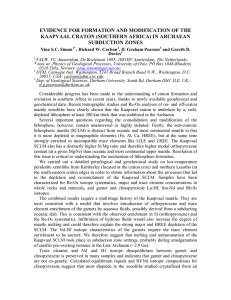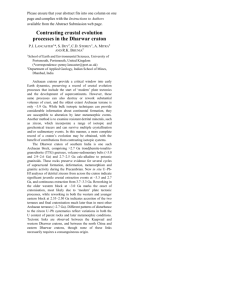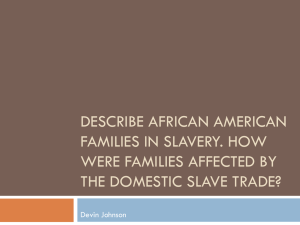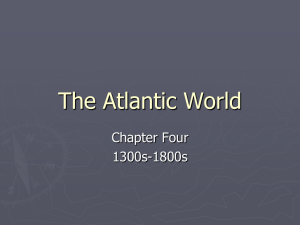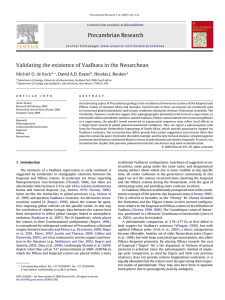Reconciling geophysical and geochemical data to
advertisement
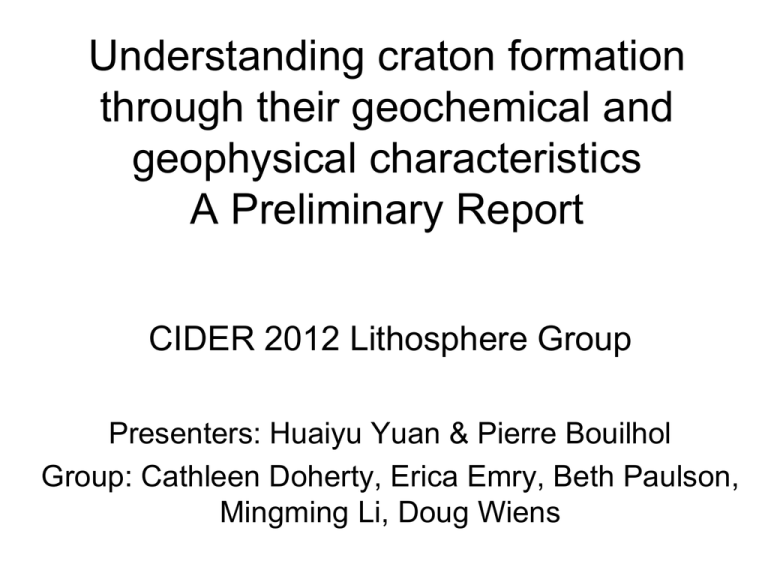
Understanding craton formation through their geochemical and geophysical characteristics A Preliminary Report CIDER 2012 Lithosphere Group Presenters: Huaiyu Yuan & Pierre Bouilhol Group: Cathleen Doherty, Erica Emry, Beth Paulson, Mingming Li, Doug Wiens Getting Started…. • History of the project • Who’s involved – 8 members of the group – 4 geophysicists, 3 geochemists, 1 geodynamicist Goals of Project • First order observations: – Layered vs. non-layered, corresponding to differences in composition. – Why are these cratons are so different? but still all cratons? • 3 Cratons – try to bring together existing geophysical observations – new geophysical evidence where needed (Beth SRF study) – try to add existing geochemical database of xenoliths and crustal rocks. • Main goal: understand the differences between cratons, which would ultimately help us to better understand their formation… Focus Sites • Three cratons: – Slave – Kaapvaal – North Atlantic • Slave & Kaapvaal are both well-studied, lots of geophysical & geochemical datasets • North Atlantic has some xenolith data, but few geophysical experiments Slave Dipping Upper mantle reflector at 100 km indicates fossil subductions Bostock 1998 Slave P-wave receiver functions Electrical Resistivity Chen et al. 2009; Jones et al. 2003 o o Spatial overlap of velocity discontinuity (left; from receiver functions) and conductive anomaly (right; from Magnitotelluric studies) indicates paleosubduction interface Other receiver functions see the boundary too (et. Abt et al. 2010; Miller et al 2011; Yuan et al 2006) Slave Shallow Anisotropy shallow “red” layer = highly depleted chemical layer (Mg# 92%) Slave Craton Griffin et al. Lithos, 2004 Yuan and Romanowicz 2010 Slave • To add: – Ages – More constraints on error/uncertainty – More geochemical data Slave Slave fossil subductions indicated by “dipping upper mantle reflectors” from LithoProbe project in many places van der Velden and Cook JGR 2005 Subduction trench (suture) parallel van der Velden and Cook JGR 2005 = Shallow Anisotropy Direction Yuan et al. 2011 North Atlantic: • New data from Receiver Function North Atlantic Craton Limited # of SRFs: indicating presence of layering in the shallow upper mantle around 100 km depth. Shear-wave receiver functions in the North Atlantic craton North Atlantic Craton Chemical Layering from olivine Mg #: shallow, highly depleted ver. bottom less depleted North Atlantic craton is consistent with North American craton in general • N. Atlantic Craton seems to show geophysical similarities with Slave craton Kaapvaal • Kaapvaal is different from Slave and North Atlantic craton • No evidence for layering within the lithosphere Kaapvaal Group 2 Group 1 Yuan & Romanowicz, AGU 2012 DI21A-2352 Kaapvaal Group 2 Anisotropy Direction Group 1 Shear Velocity Variation Yuan & Romanowicz, AGU 2012 DI21A-2352 Kaapvaal • No obvious conductivity layering in Kaapvaal Evans et al, JGR, 2011 Kaapval • Shear velocity w/ depth, no indication of layering • MT also no indication of layering (not pictured…yet) • Mg # changes significantly at ~175 km • Receiver function at 170-180 km (Hansen et al, 2009; Kind et al, 2012 AGU) Kaapvaal • Working hypothesis for Kaapvaal Slave & North Atlantic? Kaapvaal? Lee, Annu. Rev. Earth Planet. Sci. 2011 Working hypothesis for Slave Ongoing Work…. • Refine Geophysical data, include similar datasets/observations for the three cratons more receiver functions can be added • Significant work for geochemistry – Compile Re/Os for the lithosphere, compare it with TDM from Sm/Nd and Hf of the crust. – A closer look to the C and O isotopic composition of the diamonds. Numerical modeling: how does subduction influence stability of Craton roots? • Motivation: dehydration of slabs releases water, which is carried further away with regional convection and influences the rheology and composition of Craton roots. Stable Craton Destroyed Craton Thank you
